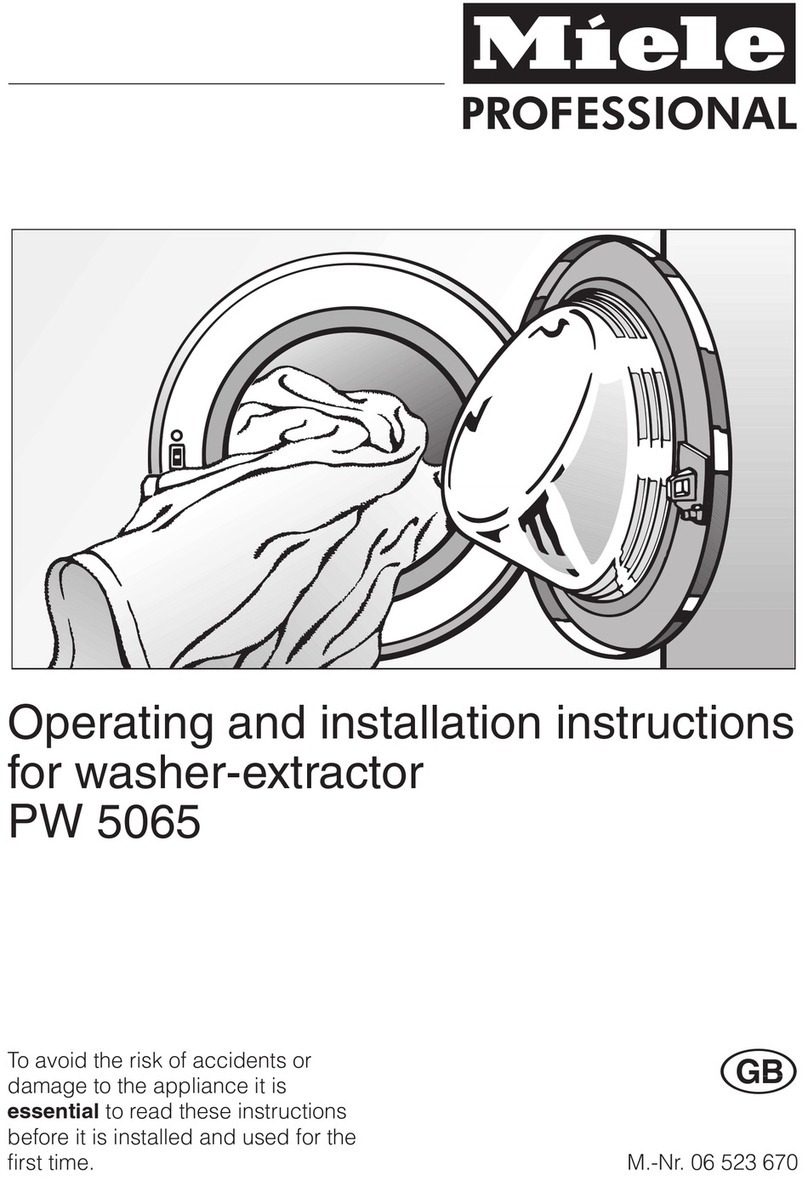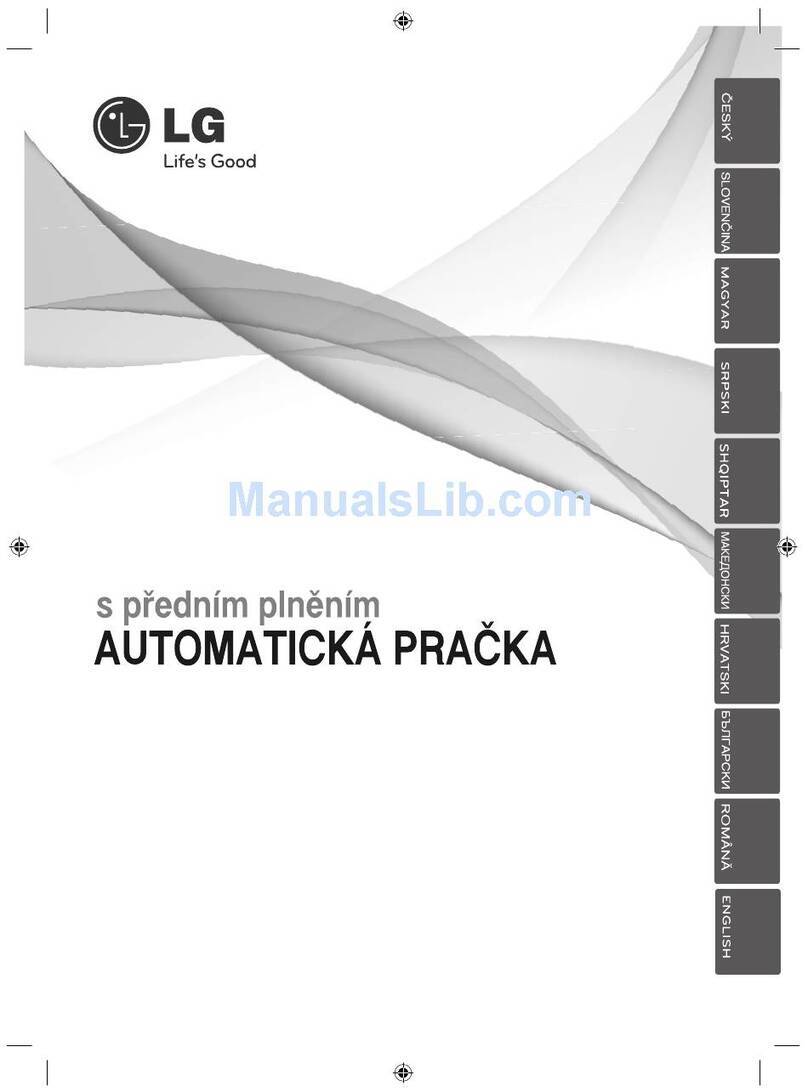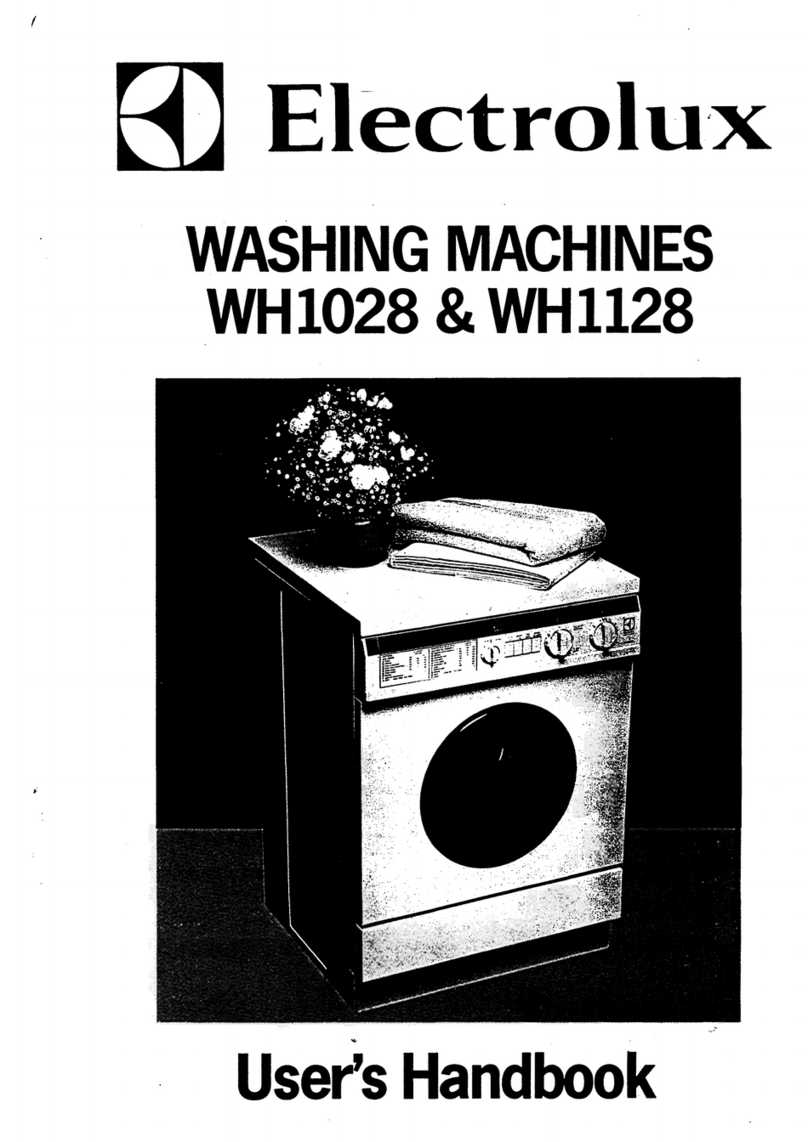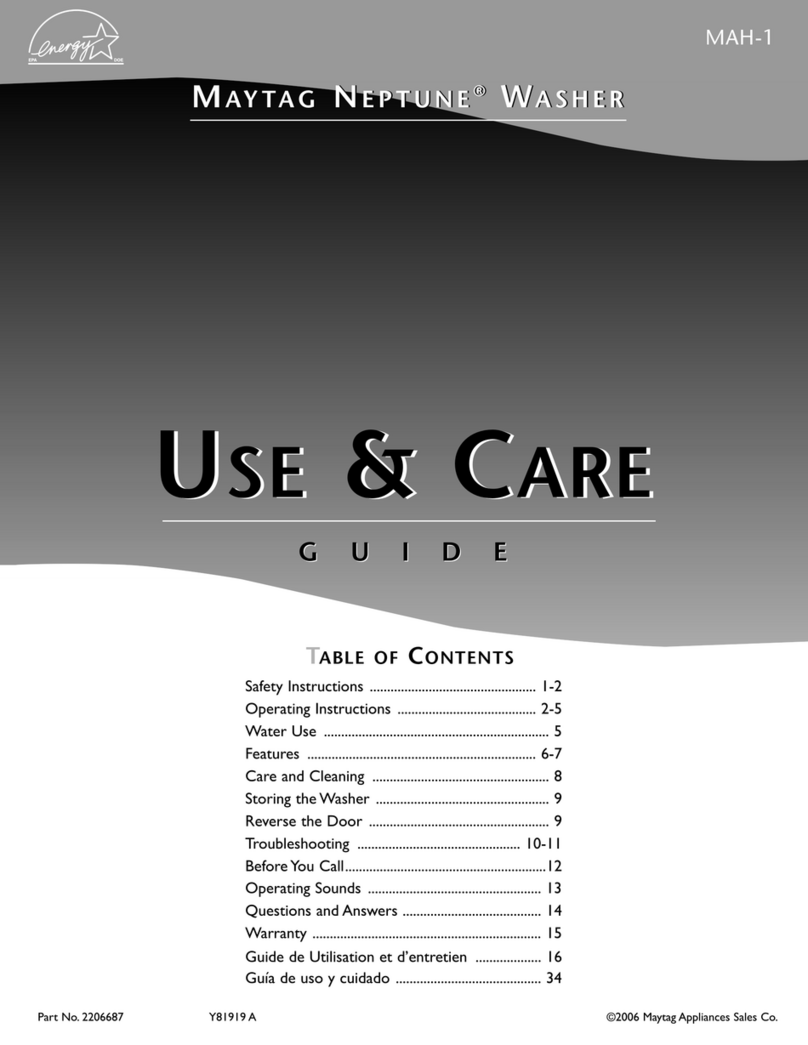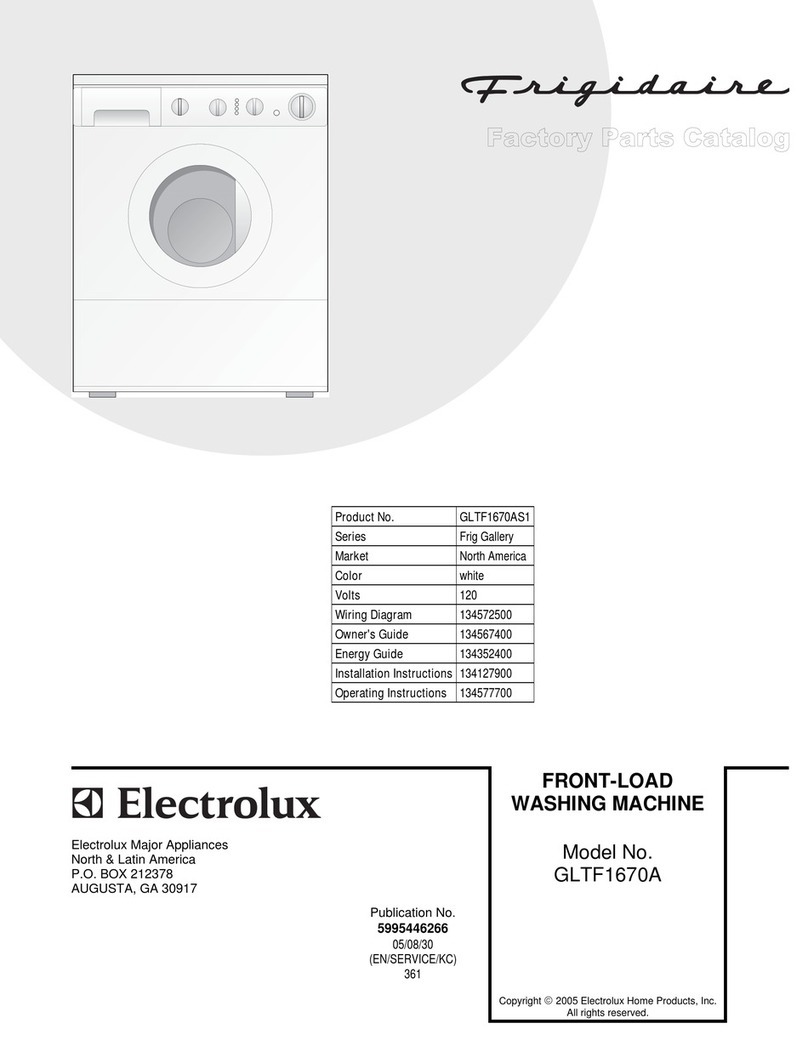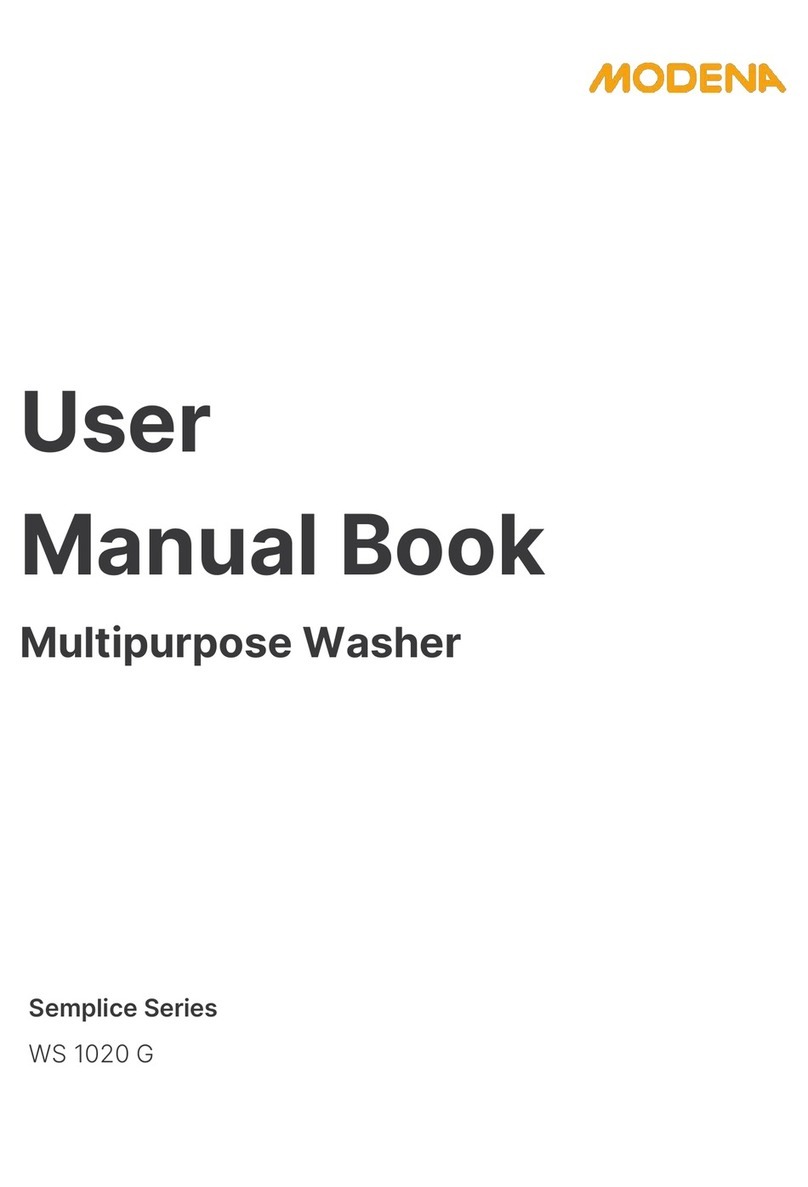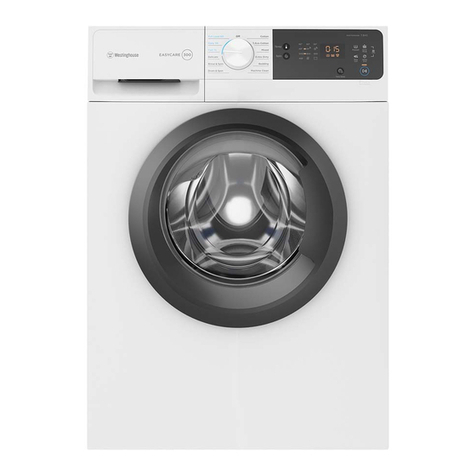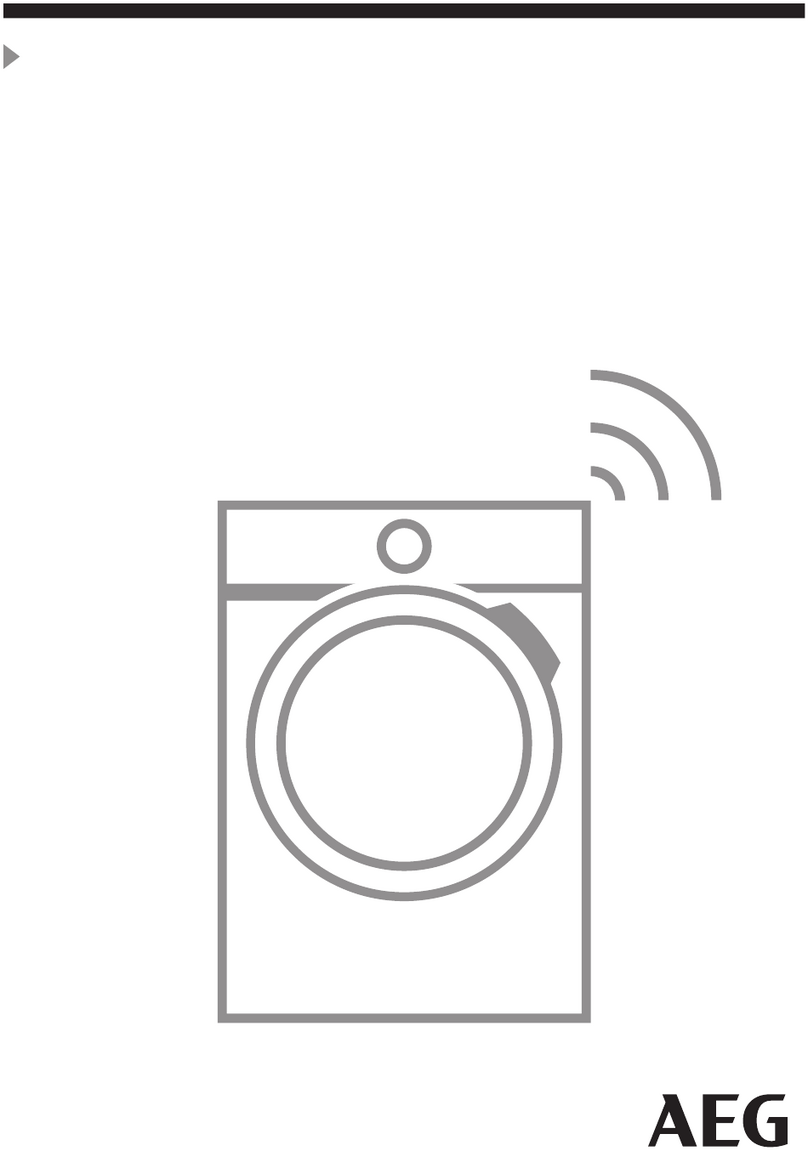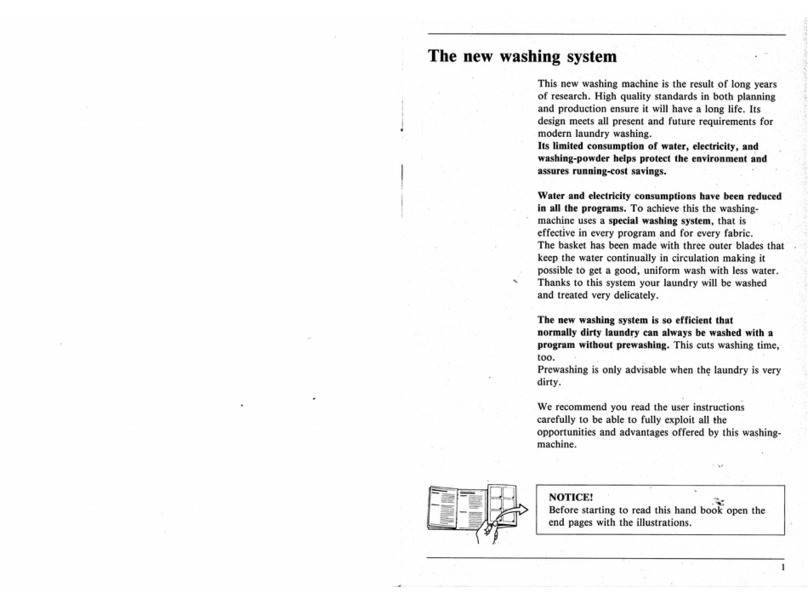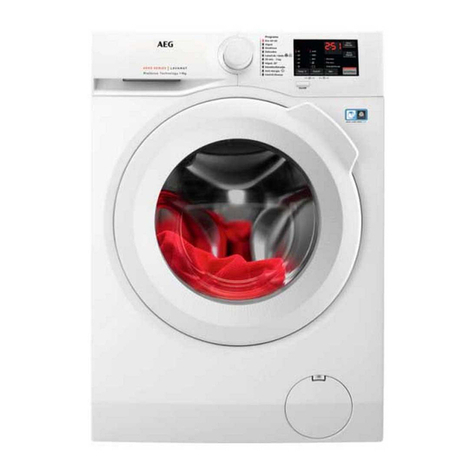Steris ML 222 User manual

Operating Instructions for
ML 222
Washer/Disinfector
To prevent accidents
and reduce the risk of ö
damaging the machine,
read the Operating Instructions before
installing or using the machine. M.-Nr. 04 666 562

Contents
Guide to the machine. . . . . . . . . . . . . . . . . . . . . . . . . . . . . . . . . . . . . . . . . . . . . . . 4
Indications for use . . . . . . . . . . . . . . . . . . . . . . . . . . . . . . . . . . . . . . . . . . . . . . . . . 6
High-level disinfection . . . . . . . . . . . . . . . . . . . . . . . . . . . . . . . . . . . . . . . . . . . . . . . 6
Cleaning without disinfection . . . . . . . . . . . . . . . . . . . . . . . . . . . . . . . . . . . . . . . . . . 7
WARNINGS AND SAFETY INSTRUCTIONS . . . . . . . . . . . . . . . . . . . . . . . . . . . . . 8
WARNINGS AND SAFETY INSTRUCTIONS (detachable) . . . . . . . . Center pages
Installation . . . . . . . . . . . . . . . . . . . . . . . . . . . . . . . . . . . . . . . . . . . . . . . . . . . . . . 12
Electrical connection . . . . . . . . . . . . . . . . . . . . . . . . . . . . . . . . . . . . . . . . . . . . . . 14
Plumbing. . . . . . . . . . . . . . . . . . . . . . . . . . . . . . . . . . . . . . . . . . . . . . . . . . . . . . . . 15
Help to protect our environment. . . . . . . . . . . . . . . . . . . . . . . . . . . . . . . . . . . . . 16
Adjusting the water softener. . . . . . . . . . . . . . . . . . . . . . . . . . . . . . . . . . . . . . . . 17
Opening and closing the door . . . . . . . . . . . . . . . . . . . . . . . . . . . . . . . . . . . . . . 19
Loading the washer/disinfector . . . . . . . . . . . . . . . . . . . . . . . . . . . . . . . . . . . . . 20
Loading accessory baskets/inserts . . . . . . . . . . . . . . . . . . . . . . . . . . . . . . . . . . . . 20
Loading the washer/disinfector . . . . . . . . . . . . . . . . . . . . . . . . . . . . . . . . . . . . . . . 21
Loading examples . . . . . . . . . . . . . . . . . . . . . . . . . . . . . . . . . . . . . . . . . . . . . . . . . 21
Adjustable upper basket . . . . . . . . . . . . . . . . . . . . . . . . . . . . . . . . . . . . . . . . . . . . 23
Loading instructions for MIS injector mobile unit ME00-450. . . . . . . . . . . . . . 24
Adding ML Neutral pH Detergent . . . . . . . . . . . . . . . . . . . . . . . . . . . . . . . . . . . . 28
Priming the neutralizer dispensing system . . . . . . . . . . . . . . . . . . . . . . . . . . . . . . 28
Adding detergent . . . . . . . . . . . . . . . . . . . . . . . . . . . . . . . . . . . . . . . . . . . . . . . . . 30
Adding liquid detergent . . . . . . . . . . . . . . . . . . . . . . . . . . . . . . . . . . . . . . . . . . . . . 30
Priming the liquid dispensing system . . . . . . . . . . . . . . . . . . . . . . . . . . . . . . . . . . 31
Cycle selection . . . . . . . . . . . . . . . . . . . . . . . . . . . . . . . . . . . . . . . . . . . . . . . . . . . 32
Contents
2

Washer/Disinfector operation . . . . . . . . . . . . . . . . . . . . . . . . . . . . . . . . . . . . . . . 34
Cycle Operation . . . . . . . . . . . . . . . . . . . . . . . . . . . . . . . . . . . . . . . . . . . . . . . . . . 34
Cycle phase indicators . . . . . . . . . . . . . . . . . . . . . . . . . . . . . . . . . . . . . . . . . . . . . 35
Selecting an additional cycle. . . . . . . . . . . . . . . . . . . . . . . . . . . . . . . . . . . . . . . . . 35
Interrupting a cycle . . . . . . . . . . . . . . . . . . . . . . . . . . . . . . . . . . . . . . . . . . . . . . . . 36
Unloading the washer/disinfector. . . . . . . . . . . . . . . . . . . . . . . . . . . . . . . . . . . . 37
Programming special functions . . . . . . . . . . . . . . . . . . . . . . . . . . . . . . . . . . . . . 38
Reactivating the water softener . . . . . . . . . . . . . . . . . . . . . . . . . . . . . . . . . . . . . 40
Cleaning and care . . . . . . . . . . . . . . . . . . . . . . . . . . . . . . . . . . . . . . . . . . . . . . . . 42
Maintaining the filter assembly. . . . . . . . . . . . . . . . . . . . . . . . . . . . . . . . . . . . . . . . 42
Maintaining the dispensing system . . . . . . . . . . . . . . . . . . . . . . . . . . . . . . . . . . . . 43
Maintaining the drying unit. . . . . . . . . . . . . . . . . . . . . . . . . . . . . . . . . . . . . . . . . . . 44
Correcting minor problems. . . . . . . . . . . . . . . . . . . . . . . . . . . . . . . . . . . . . . . . . 46
Read all instructions before using the washer/disinfector.
This equipment is suitable for the applications mentioned in the operating instruc-
tions. Do not use for purposes other than those for which it was designed, as
these may be dangerous. The manufacturer cannot be held responsible for dam-
age caused by improper use.
Contents
3

Guide to the machine
1 CHECK WATER INLET/DRAIN
indicator light
2 REACTIVATE WATER SOFTENER
indicator light
3 ADD LIQUID DETERGENT
indicator light
4 ADD NEUTRALIZING AGENT
indicator light
5 Cycle phase indicator lights
6 Indicator display field
7 Door release button
8 On-Off button
9 Cycle selector touch pads
Guide to the machine
4

10 Dispenser for detergent (blue) and
neutralizing agent (red)
11 Filter assembly
12 Safety fuse (anti-block feature) for
Drying unit
13 Operating hours counter for
Drying unit
14 Temperature selector for
Drying unit
15 Service panel
16 Dispenser for liquid surfactant
with dosage selector
17 Level indicator
18 Filter combination
19 Salt container socket
(water softener)
Guide to the machine
5

Indications for use
High-level disinfection
The ML 222 Washer/Disinfector is suit-
able for automatic treatment of medical
instruments and accessories. It cleans
and, when using the disinfection cycles
simultaneously, thermally disinfects at
200°F (93°C) instruments and acces-
sories.
Areas of effectiveness are physical
removal or thermal inactivation of vege-
tative bacteria including mycobacteria,
fungi, fungal spores, and viruses.
These categories include the Mycobac-
terium tuberculosis and the Entero-
coccus faecium.
IMPORTANT: Only the cycles labeled
‘DISINFECTION’ disinfect! Only use
these cycles when handling contami-
nated items. All other cycles are de-
signed to clean items without disinfect-
ing them!
The ML 222 Washer/Disinfector
achieves high-level disinfection as
defined by the Spaulding categorization.
IMPORTANT: Centers for Disease Con-
trol Publication PB85-923404, Guide-
line for Handwashing and Hospital Envi-
ronmental Control, 1985, defines the
processing requirements for critical,
semicritical and non-critical instru-
ments. Refer to these definitions to
determine when and under what condi-
tions the ML 222 Washer/Disinfector
can be used.
Instruments Suitable for Processing
in the Washer/disinfector
All instruments, accessories, and other
items to be cleaned and disinfected in
the ML 222 Washer/Disinfector must
have the following properties:
Heat resistance to temperatures of at
least 200°F (93°C)
Corrosion resistance in the presence
of heat, alkalinity and water.
Certain items and materials are not
suitable for processing in the
Washer/disinfector.
Do not process:
carbon steel devices as they may
corrode;
flexible endoscopes, light cables,
fiber optics, rotating devices, motors
or other electrical equipment unless
the processing is approved by the
device manufacurer.
Indications for use
6

NOTE: Aluminium devices can only be
processed using the DISINFECTION
VARIO 93°C – 10 MIN cycle with ML
Neutral PH Detergent as they may dis-
color otherwise.
NOTE: Always contact the device
manufacturer to confirm processing
compatibility if you have any concerns
about the suitability of a specific item.
The ML 222 Washer/Disinfector is an ef-
fective processor for many medical in-
struments and accessories. It is an effi-
cient washer and, when a disinfection
cycle has been selected, it thermally
disinfects at 200°F (93°C).
WARNING –POTENTIAL BIOHA-
ZARD: Always use DISINFECTION
cycles when processing medical in-
struments and accessories. Only
DISINFECTION cycles provide high
levels of disinfection.
Cleaning without disinfection
All other cycles are designed to clean
goods without disinfecting them. These
programs are:
RINSE
WASH 93°C
Please refer to "Cycle selection" for de-
tailed information.
Indications for use
7

WARNINGS AND SAFETY INSTRUCTIONS
The following is a summary of the safety precautions which must be observed
when operating and servicing this equipment. These precautions are repeated (in
whole or in part), where applicable throughout the manual.
All relevant safety procedures must be obeyed. Relevant safety procedures
include, but are not limited to, the Centers for Disease Control’s Recom-
mended Infection Control Practices and the OSHA Bloodborne Pathogens
Standard.
READ ALL INSTRUCTIONS BEFORE
USING THE APPLIANCE
WARNING –
The manufacturer cannot accept responsibility for damage caused when the
appliance is not used according to the instructions, or for uses other than
those for which it was intended.
The manufacturer cannot be held responsible for problems or injuries result-
ing from improper installation, use or operation of this equipment.
WARNING –PERSONAL INJURY
HAZARD: Do not allow small child-
ren or unauthorized personnel access
to the washer/disinfector or its controls.
WARNING –EXPLOSION
HAZARD: Do not install the
washer/disinfector in areas where
flammable compounds/vapors are
present.
WARNING –PERSONAL INJURY/
EQUIPMENT DAMAGE HAZARD:
Repair work must be carried out only
by a qualified and competent service
technician. Repairs by unqualified per-
sons or installation of unauthorized
parts could cause personal injury, re-
sult in costly equipment damage or
void the washer/disinfector warranty.
WARNINGS AND SAFETY INSTRUCTIONS
8

WARNING –BURN HAZARD:
Except for emergency, do not
open door when cycle is in process. In
an emergency, first stop the cycle by
pressing ON/OFF button. Press DRAIN
touch pad and wait for washer/disinfec-
tor to drain. Wear protective gloves and
face shield whenever reaching into
wash cabinet.
WARNING –ELECTRICAL SHOCK
HAZARD: Disconnect all utilities to
equipment before servicing. Do not ser-
vice equipment unless all utilities have
been properly locked out.
WARNING –PERSONAL INJURY
HAZARD: The water in this
washer/disinfector is not suitable for
drinking.
WARNING –PERSONAL INJURY/
EQUIPMENT DAMAGE HAZARD:
Only use detergents which have been
approved of by STERIS. Use of any
other products may cause personal in-
jury, invalidate the disinfection results
or void the washer/disinfector warranty.
WARNING –CHEMICAL BURN
HAZARD: Wear protective gloves
and goggles and use care when hand-
ling liquids such as detergents or neu-
tralizing agents. Read and follow the in-
structions and safety procedures on
the packaging and in the Material
Safety Data Sheet (MSDS).
WARNING –PERSONAL INJURY/
EQUIPMENT DAMAGE HAZARD:
Empty containers and glassware be-
fore placing in the washer/disinfector.
Do not allow any acids or solvents, es-
pecially hydrochloric acid and
chlorides, to get into the wash cabinet.
WARNING –PERSONAL INJURY
HAZARD: Be careful when sorting
instruments with sharp pointed ends. If
possible, place the pointed end down-
wards.
WARNING –PERSONAL INJURY/
EQUIPMENT DAMAGE HAZARD:
Internal cleaning and disinfecting to a
measurable standard can only be
achieved with instruments that can be
dismantled and where the jets, sleeves
and adapters are used appropriately. A
special examination, over and above a
visual one, of the cleanliness of the
inner area of the instruments should be
made. Minimally invasive surgical (MIS) in-
struments should preferably be processed
using the DISIN VARIO 93°C-10 MIN or
DISIN 93°C-10 MIN program with recom-
mended detergents.
WARNINGS AND SAFETY INSTRUCTIONS
9

WARNING –BURN HAZARD:
Allow accessories to cool to room
temperature before unloading. Any
water which may have collected in in-
correctly loaded items will be very hot
and should be emptied into the wash
cabinet.
WARNING –BURN HAZARD:
Do not touch the heating elements
in wash cabinet after the end of a cycle.
WARNING –TIPPING HAZARD:
Do not sit or lean on the open door.
This could cause the washer/disinfec-
tor to tip.
WARNING –FALL HAZARD:
To prevent falls, keep floors dry by
immediately wiping up any spilled
liquids in washer/disinfector loading
and unloading areas.
WARNING –ELECTRIC SHOCK
HAZARD: Washer/disinfector must
be correctly grounded!
WARNING –POTENTIAL BIOHA-
ZARD: Always use DISINFECTION
cycles when processing medical instru-
ments and accessories. Only DISIN-
FECTION cycles provide high levels of
disinfection.
WARNING –PERSONAL INJURY/
EQUIPMENT DAMAGE HAZARD:
Do not fill container with cleaning deter-
gent! Fill with reactivation salt only!
Otherwise the pressurized container
may cause injuries by unscrewing.
WARNINGS AND SAFETY INSTRUCTIONS
10

CAUTION: Washer/disinfector
must not be used without all filters
in place.
CAUTION: Use only accessories
specifically designed for this equip-
ment. Load accessories into washer/
disinfector in accordance with the in-
structions provided.
CAUTION: The operator is respon-
sible for monitoring and guarante-
eing the standard of disinfection in the
routine disinfection cycle. Disinfection
parameters should be checked regu-
larly using chemical indicators, and
contamination levels checked and do-
cumented periodically using biological
indicators.
SAVE THESE
INSTRUCTIONS
WARNINGS AND SAFETY INSTRUCTIONS
11

Installation
WARNING –EXPLOSION HAZARD:
Do not install the washer/disinfector
in area where flammable com-
pounds/vapors are present.
IMPORTANT: The machine should only
be installed by a competent contractor.
The contractor should be experienced
in installing machines that require elec-
trical hook-up as well as plumbing.
The machine can be installed in the fol-
lowing ways:
Free-standing
Under counter.
The recess should be at least
23-3/4" (60 cm) wide, 23-3/4" (60 cm)
deep, and 33-1/4" (85 cm) high.
Washer/disinfector can be built into a
recess of 32-1/4" (83 cm) high by remov-
ing the washer/disinfector top.
If necessary the washer/disinfector top
can be removed as follows:
Open the door.
Remove the screws on the left and
right, using a Philips screw driver.
Pull the top forward, lift and remove.
Installation
12

The machine must be installed and
leveled correctly. Any unevenness in
the floor can be compensated for by
screwing the adjustable feet in or out
as necessary. To level this unit, the ser-
vice panel and kickplate must first be
removed.
To remove the service panel and kick-
plate:
Take hold of the service panel at the
top of both sides and pull forward.
Remove all four kickplate screws.
Disconnect grounding lead if ne-
cessary.
Remove plastic protective cap.
To re-assemble:
Replace plastic protective cap, kick-
plate facing and service panel in the
reverse order which they were
removed.
Make sure the grounding lead is re-
connected.
Do not use silicone sealant to seal
the gaps between the machine and
any neighboring units as this will hin-
der ventilation to the circulation
pump.
Depending on the installation require-
ments, the following kit is available:
Steam deflector (P-16 MLE)
For use where the machine will be in-
stalled under a wooden countertop.
The underside of the work surface is
protected from steam damage by a
plate of stainless steel.
Installation
13

Electrical connection
IMPORTANT: All electrical work must
be carried out by a qualified electrician
and in compliance with all local and na-
tional electrical codes.
Before making any connections, check
that the voltage shown on the data
plate corresponds to your power sup-
ply. Data plate is located on back of
unit and behind service panel.
The washer/disinfector is supplied as
standard for connection to a 208 V,
60 Hz, single phase power supply and
is fitted with a power supply cord 6 ft
(1.8 m) long with a cross-section of
AWG 10-4. Connect washer/disinfector
to the main power supply (junction box
or electrical cord to outlet) according to
the opposite chart.
NOTE: If an electrical cord is used,
make sure cord is the proper size and
voltage/current rating for the washer/
disinfector as identified on the data
plate.
Voltage: 208 V, single phase
Frequency: 60 Hz
Rated load: 6.0 kW
Circuit breaker: 30 A per phase
The washer/disinfector can be con-
verted for connection to a 3-phase
power supply.
WARNING –ELECTRICAL SHOCK
HAZARD: Washer/disinfector must
be correctly grounded!
The wiring diagram can be found be-
hind the kickplate on the left hand side,
attached to the floor of the machine.
The data plate with serial and model
numbers is on the rear of the machine
and on the kickplate behind the service
panel.
Electrical connection
14

Plumbing
Connection to the cold water inlet
The machine must be connected to
the water supply in accordance with
all local and national plumbing
codes.
The machine is constructed with an
air gap/anti-siphoning device on
both the intake and the drain sides.
No such additional devices are
necessary or recommended, as they
will impede the water inflow into and
out of the washer.
The water pressure must be be-
tween 35 and 145 psi (2.5 - 10.0
bar). If the water pressure is not
within this range, STERIS Engineer-
ing Service can advise you of the
measures to be taken (see "Pro-
gramming special functions").
This machine is designed for cold
water connection only. Both inlet
hoses (water supply and steam con-
denser) must be connected to the
valves for cold water. Cold water sup-
ply must be provided with shut off
valves (by others).
Valves with 3/4’’ male hose thread
should be provided near the washer,
and should be easily accessible.
For additional protection of the
valves against impurities in the water
supply, large surface area filters are
enclosed in the kit supplied with the
machine (see diagram in "Cleaning
and care, Maintaining the filter as-
sembly").
Hose Color Water type
Blue
Green
Cold water
Demineralised water
WARNING –PERSONAL INJURY
HAZARD: The water in the washer/
disinfector is not suitable for drink-
ing.
Drainage
The drain system is equipped with a
non-return valve which prevents dirty
water from flowing back into the
washer/disinfector.
The machine is supplied with two
5 ft (1.5 m) long flexible drain hoses
with an inner diameter of 3/4’’ (2 cm).
They should not be shortened or at-
tached to any fittings that would cause
a reduction in water flow.
Longer drain hoses up to a length of
13 ft (3.3 m) are available if required.
Both hoses can be attached to exist-
ing drain lines through the use of a 1-
1/2’’ (3.5 cm) or larger stand pipe /
P-trap combination. Alternately, the
hoses can be connected directly to
existing drain lines, provided any fit-
tings or adapters used do not re-
duce the water flow.
The drain hoses must not exceed
13 ft (3.3 m) in length, or be at-
tached to the main drain at a point
higher than 3 ft (1m) above the floor.
A floor drain is permissible.
Plumbing
15

Help to protect our environment
Disposal of the packaging material
The transport and protective packa-
ging is mostly manufactured from the
following reusable materials:
corrugated paper/cardboard
polystyrene (CFC-free)
polyethylene foil (transparent)
untreated wood
Rather than throwing these materials
away, please take them to the nearest
recyclables collection point.
Disposal of your old machine
Old machines contain materials which
can be recycled. Please contact your
local salvage yard about potential recy-
cling options before disposal.
Before disposing, run the DRAIN pro-
gram to make sure that no residual
fluids are left in the sump of the ma-
chine.
When disposing of an old machine,
make sure the door catch is removed.
This will prevent children at play from
being accidentally locked in.
Help to protect our environment
16

Adjusting the water softener
To avoid the build-up of calcium de-
posits on items being cleaned and dis-
infected in the washer/disinfector, the
water may need to be softened (where
the supply hardness exceeds 107 ppm
CaCO3).
To ensure a steady supply of soft water,
the water softener must always be:
correctly set
regenerated with salt as soon as the
REACTIVATION indicator light comes
on.
The water softener should be set to
correspond with the water hardness
upon installation of the washer/ disinfec-
tor.
Your local water authority can advise
you on the water hardness in your area.
Setting the water softener
The hardness range is divided into 18
units and a zero position. The washer/
disinfector is set at the factory for a
water hardness setting of 8, corre-
sponding to 339 ppm CaCO3. If your
water supply is harder or softer than
this, change the setting as follows:
Time
set-
ting
°d
gr/gal
mmol/
l
°f °eppm
CaCO3
18
17
16
15
14
13
12
11
10
9
8
7
6
5
4
3
2
1
0
6
7
8
9
10
11
12
13
15
17
19
22
24
28
32
38
48
71
1.07
1.25
1.42
1.60
1.78
1.96
2.14
2.31
2.67
3.03
3.38
3.92
4.27
4.98
5.70
6.76
8.54
12.64
10.7
12.5
14.3
16.0
17.9
19.6
21.4
23.2
26.8
30.4
33.9
39.3
42.8
50.0
57.1
67.8
85.7
126,7
7.5
8.8
10.0
11.3
12.5
13.8
15.0
16.3
18.8
21.3
23.8
27.5
30.0
35.0
40.0
47.6
60.1
88.9
107
125
143
160
179
196
214
232
268
304
339
393
428
500
571
678
857
1267
1. Using table provided, identify correct
"Display Field" number that corre-
sponds to your local water hardness.
2. Press the DRAIN and DRYING touch
pads simultaneously and, while de-
pressed, turn the machine on, using
the main ON/OFF switch.
"P3" will appear in the display field.
3. Press the REACTIVATION touch pad.
The "P3" will disappear and setting
"0" will appear in the display field.
Adjusting the water softener
17

4. Press the DRYING touch pad as
many times as necessary for the
desired value to appear in the dis-
play field.
5. Press the START touch pad.
"SP" appears in the display field.
6. Press START once more. The setting
will now be stored. The display field
clears.
7. The washer/disinfector is now ready
for operation.
If the water hardness in your area is
permanently below 107 ppm CaCO3,
you do not need to soften the water.
Please deactivate the water softener by
selecting the setting "0" in the display
field according to above instructions.
The REACTIVATION indicator light will
not come on and the water softener will
not need to be reactivated.
For instructions on reactivating the
water softener, see "Reactivating the
water softener".
Adjusting the water softener
18

Opening and closing the door
To open the door
Press the DOOR button on the con-
trol panel and open the door.
WARNING –BURN HAZARD: Ex-
cept for emergency, do not open
door when cycle is in process. In an
emergency, first stop the cycle by
pressing ON/OFF button. Press
DRAIN touch pad and wait for
washer/disinfector to drain. Wear
protective gloves and face shield
whenever reaching into wash
cabinet.
The door should only be opened dur-
ing cycle operation for emergencies,
e.g. if articles are knocking together.
(Refer to "Interrupting a cycle".)
WARNING - TIPPING HAZARD: Do
not sit or lean on open door.
To close the door
Lift the door upwards and push until
it clicks into position. Do not press
the DOOR button.
Opening and closing the door
19

Loading the washer/disinfector
CAUTION: Use only accessories
specifically designed for this equip-
ment.
The washer/disinfector normally uses
an upper and a lower basket.
Depending on the type and shape of
the items being cleaned, accessory
baskets and inserts can be utilized. Se-
lect baskets and inserts which are ap-
propriate for the application (see separ-
ate product literature).
Loading accessory baskets/
inserts
WARNING –PERSONAL INJURY/
EQUIPMENT DAMAGE HAZARD:
Empty containers and glassware be-
fore placing in the washer/disinfec-
tor. Do not allow any acids or sol-
vents, especially hydrochloric acid
and chlorides to get into the wash
cabinet.
1. Empty all items to be cleaned before
loading into the accessories.
2. Remove gross soil/debris from all
items to be cleaned before loading
into accessories.
WARNING –PERSONAL INJURY
HAZARD: Be careful when sorting
instruments with sharp pointed
ends. If possible, place pointed end
downwards.
3. Load the items to be cleaned so the
water will come into contact with all
surfaces. This ensures that they will
be properly cleaned and disinfected.
Do not place items to be cleaned in-
side other pieces where they may be
concealed.
Vessels should be inverted and
placed in the correct accessory in-
serts.
Deep-based items should be placed
at enough of an angle for water to
run off them freely.
Tall and narrow pieces should be
placed in the center of the basket to
ensure good coverage with water.
4. In order to avoid corrosion, it is rec-
ommended that only heat and corro-
sion resistant items be cleaned in
the washer/disinfector. For the suita-
bility of instruments, please refer to
”Indications for use”.
5. The spray arms must not be blocked
by items which are too high for the
basket or which hang down in its
path. If necessary, manually rotate
the spray arm to test it.
Loading the washer/disinfector
20
Table of contents
Other Steris Washer manuals

Steris
Steris Basil 4600 User manual
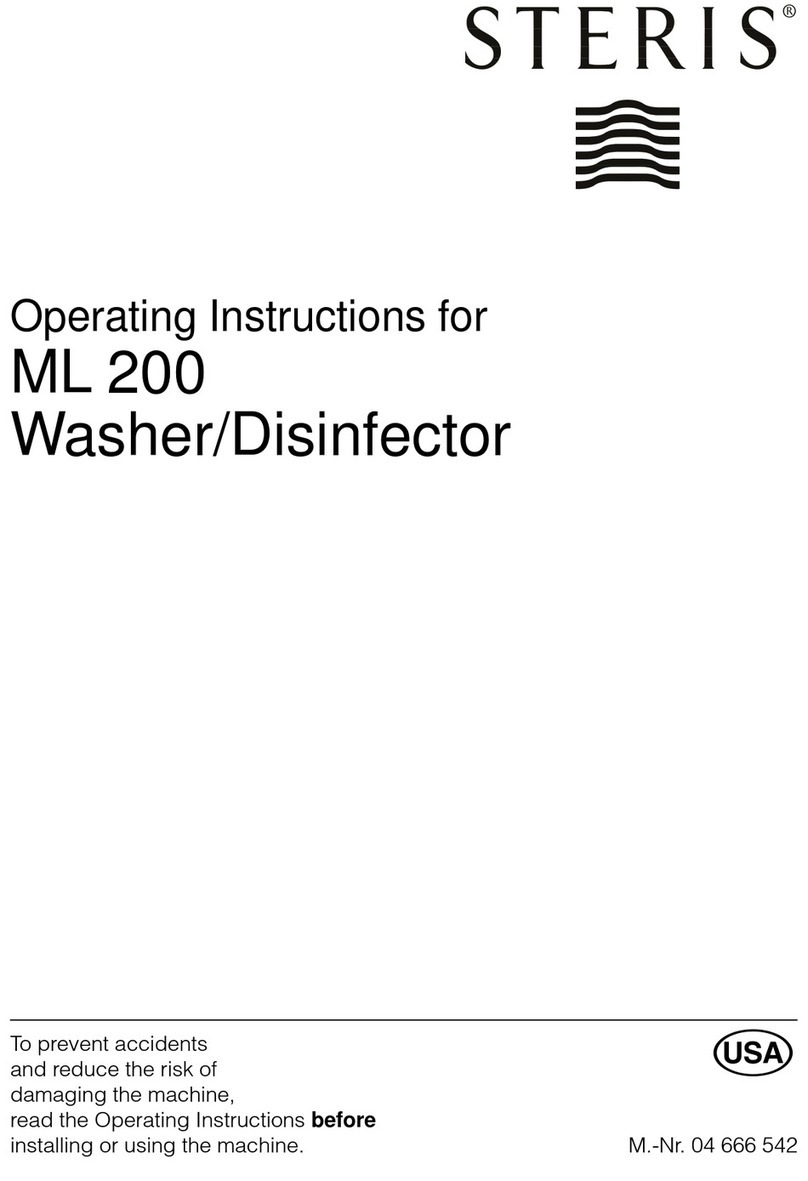
Steris
Steris ML 200 User manual
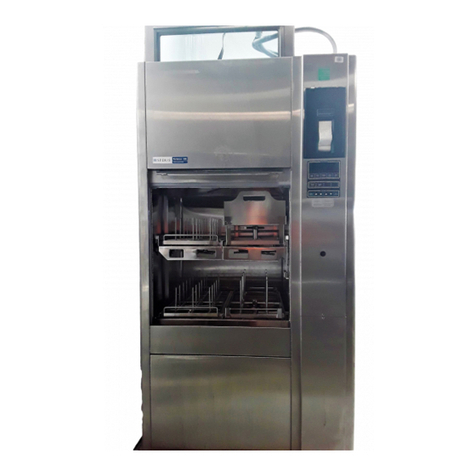
Steris
Steris RELIANCE 400 User manual
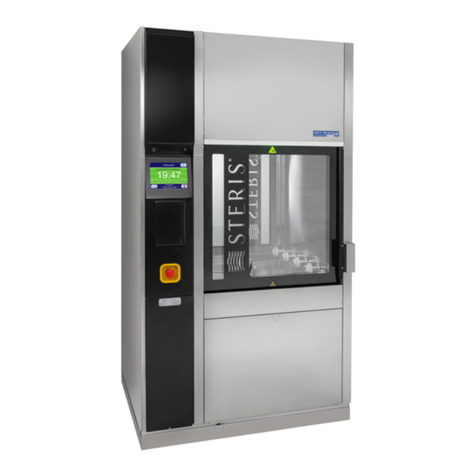
Steris
Steris AMSCO 7000 Series User manual

Steris
Steris AMSCO 5000 Series User manual

Steris
Steris Reliance 1227 User manual
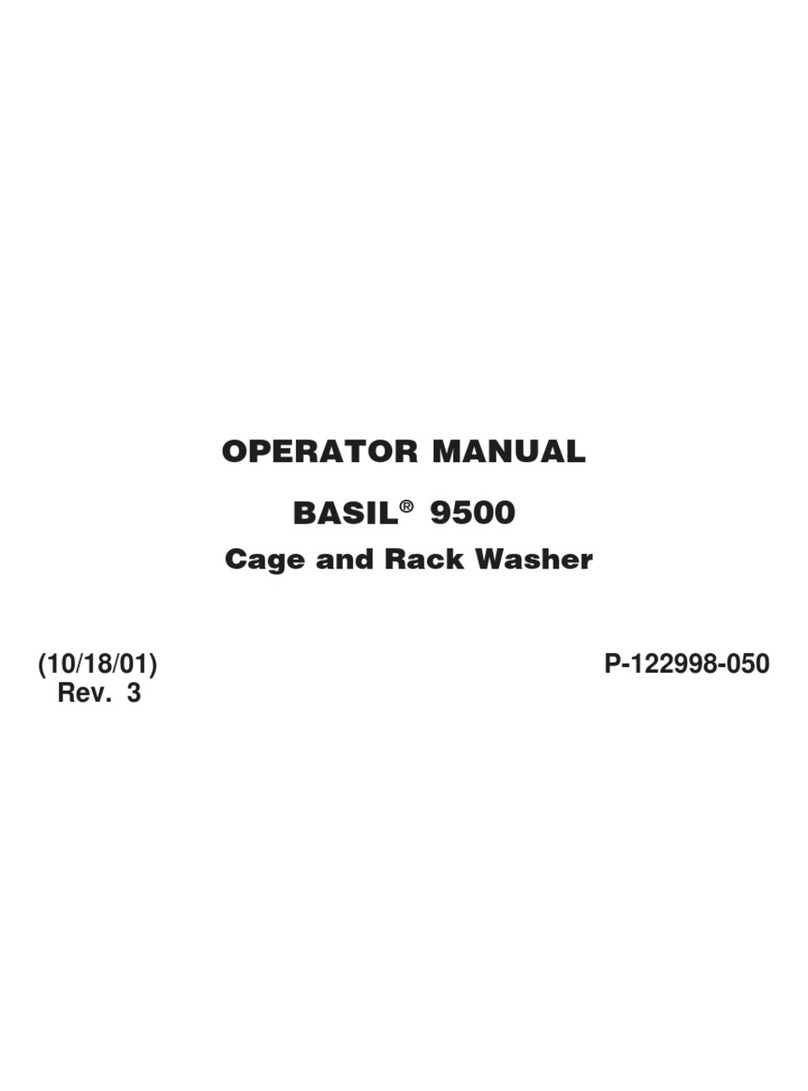
Steris
Steris BASIL 9500 User manual
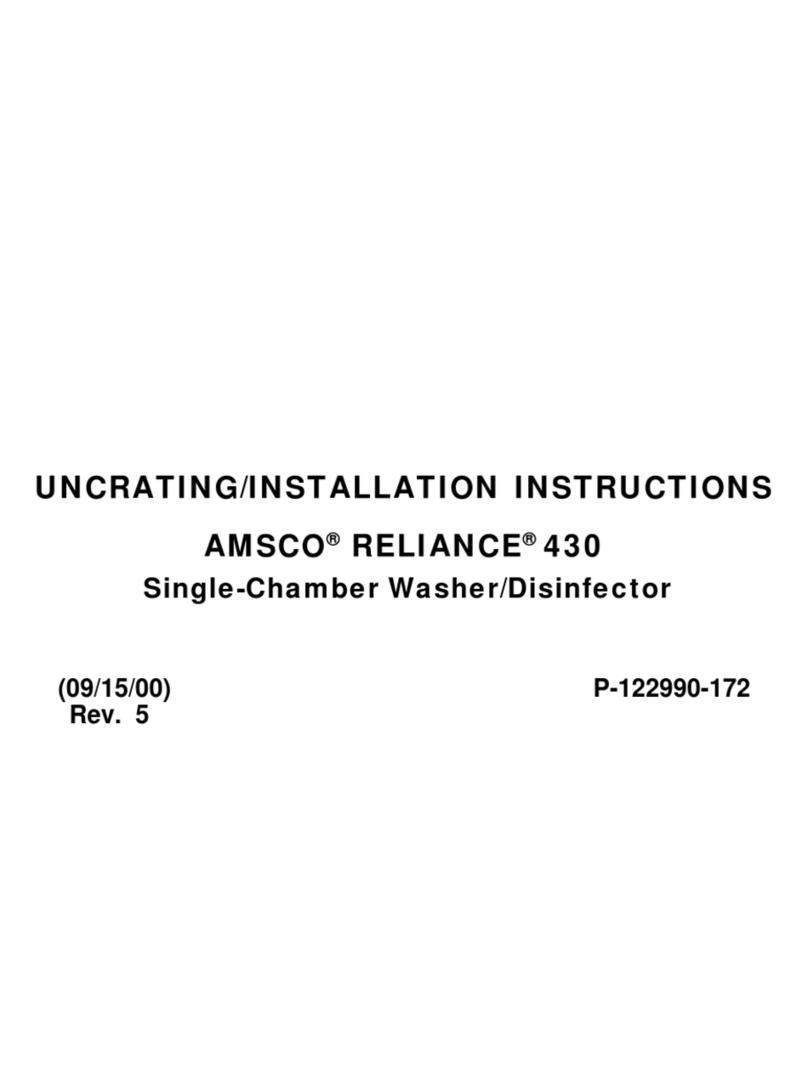
Steris
Steris AMSCO RELIANCE 430 User manual

Steris
Steris RELIANCE 200 User manual

Steris
Steris RELIANCE 400 User manual

